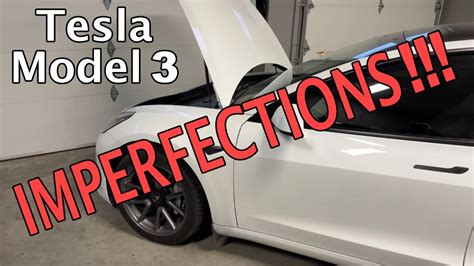The Tesla Model 3, first introduced in 2017, has been a groundbreaking electric vehicle (EV) that has captured the attention of the automotive world with its impressive range, sleek design, and innovative technology. However, like any other vehicle, it is not without its issues. Owners and potential buyers have reported several problems that have been documented over the years. Understanding these issues can provide valuable insights for those considering purchasing a Tesla Model 3 or for current owners looking to troubleshoot or anticipate potential problems.
Key Points
- Battery Degradation: Concerns over the long-term health and capacity of the battery.
- Software Updates and Features: Issues with the rollout and functionality of certain software features.
- Fit and Finish Quality: Reports of inconsistent build quality and fit and finish issues.
- Reliability and Durability: Concerns over the reliability of certain components and the vehicle's overall durability.
- Service and Support: Experiences with Tesla's service and support infrastructure.
Understanding the Tesla Model 3 Issues

Delving into the specifics of each issue provides a clearer picture of what owners and potential buyers might face. The Tesla Model 3, being an electric vehicle, has a unique set of challenges that distinguish it from its gasoline-powered counterparts. One of the primary concerns is battery degradation, which affects the vehicle’s range and overall performance over time. While Tesla’s battery technology is among the best in the industry, degradation is a natural process that occurs in all lithium-ion batteries. Tesla provides warranties for its batteries, ensuring they retain a certain level of capacity over the years, but the rate of degradation can vary based on several factors, including charging habits, climate, and driving conditions.
Battery Health and Charging Practices
A key aspect of maintaining battery health is adopting optimal charging practices. Tesla recommends avoiding extremely high or low states of charge for prolonged periods, as this can stress the battery. Additionally, keeping the vehicle’s software up to date is crucial, as Tesla often releases updates that can improve battery efficiency and health. However, the software update process itself has sometimes been a point of contention, with some updates introducing new features or fixing issues but occasionally causing unforeseen problems or removing certain functionalities. The dynamic nature of Tesla’s software-centric approach means that the vehicle is continually evolving, which can be both a benefit and a source of frustration for owners.
| Year | Battery Capacity Retention |
|---|---|
| 1 Year | 98% - 99% |
| 5 Years | 90% - 92% |
| 8 Years | 85% - 88% |

Quality and Reliability Concerns

Beyond the technological aspects, issues related to fit and finish quality have been reported by some owners. These can range from minor inconsistencies in panel gaps to more significant problems like misaligned trim pieces or uneven paint jobs. While these issues do not necessarily affect the vehicle’s performance, they can be frustrating for owners who expect a certain level of quality, especially given the Model 3’s premium pricing. Tesla has made efforts to address these concerns through improvements in its manufacturing processes and quality control measures.
Addressing Quality Concerns
In response to feedback from owners and critics, Tesla has implemented various changes to enhance the overall quality of the Model 3. This includes refinements in the production line to reduce variability in build quality, as well as design adjustments to improve the durability and reliability of certain components. For instance, reliability and durability have been areas of focus, with Tesla working to minimize the occurrence of issues that could lead to more significant problems down the line. This proactive approach demonstrates the company’s commitment to continually improving its products based on real-world feedback.
Finally, the experience with service and support is a critical aspect of owning a Tesla Model 3. While Tesla's approach to service, which often leverages remote diagnostics and over-the-air updates, can be convenient and innovative, it has also sometimes led to frustration among owners who prefer more traditional service models or face issues that require physical inspection and repair. The company has been expanding its service network and implementing new service models to better meet the needs of its growing customer base.
What is the average battery degradation of a Tesla Model 3 per year?
+The average battery degradation can vary, but Tesla's data suggests that its vehicles retain up to 90% of their battery capacity after 5 years, which translates to a minimal loss in range capability over time.
How often should I update my Tesla's software?
+Tesla recommends keeping your vehicle's software up to date. Updates are typically automatic, but it's a good practice to regularly check for and install updates manually, especially if you've been notified of a critical update.
What should I do if I encounter a fit and finish issue with my new Tesla Model 3?
+Contact Tesla's customer service or visit a local service center. They will assess the issue and provide necessary repairs or adjustments to ensure your vehicle meets Tesla's quality standards.
In conclusion, while the Tesla Model 3 is an innovative and groundbreaking vehicle, it is not immune to issues that can affect its performance, reliability, and overall ownership experience. By understanding these potential problems and how they are being addressed by Tesla, both current and prospective owners can make more informed decisions and better navigate the unique aspects of owning an electric vehicle. As the automotive landscape continues to evolve, the importance of transparency, continuous improvement, and customer feedback will only continue to grow, shaping the future of electric vehicles like the Tesla Model 3.
